Venice Museums and Churches
Venice like some many cities of architectural wonder was
born out of desperations, much like Mesa Verde.
Islands within the Venice Lagoon were habited during the times of the
Roman Empire, but Venice as we know it now really took off when the Roman
Empire fell and the cities it once protected, such as on the mainland area of the Venice Lagoon fell prey to
barbarians of the north. Citizens of
ex-Roman cities flocked to the islands of Venice seeking shelter. On those islands a unique culture and
societal system emerged, one I was recently able to experience on my tour of
the Mediterranean.
 |
| The "Bridge of Sighs", son named because it is though prisoners would sigh at their last sight of Venice before walking from their trail on the left to the prisons on the right. |
We arrived in Venice the evening of Halloween, and although
we managed to walk around the island a bit, flaunting a bit the Venetian mask I
had brought while enjoying a beer and sandwich dinner. However we were severely jet-lagged and
needed a long sleep before engaging in some serious tourism. The next day we were ready to make the most of our remaining
two and a half days in Venice. We
started by making a bee line to the nearest water bus stop. The main island of Venice is not so big as to
be unwalkable, but when constantly afoot on old stone streets my feet tend to
hurt, and without transportation that floats, we would have been unable to
visit other islands of the lagoon. We
just made the age cutoff (twenty-nine) for the
Venice water bus young person pass, granting three days of unlimited passage on
the islands’ water buses for a significantly reduced fare.
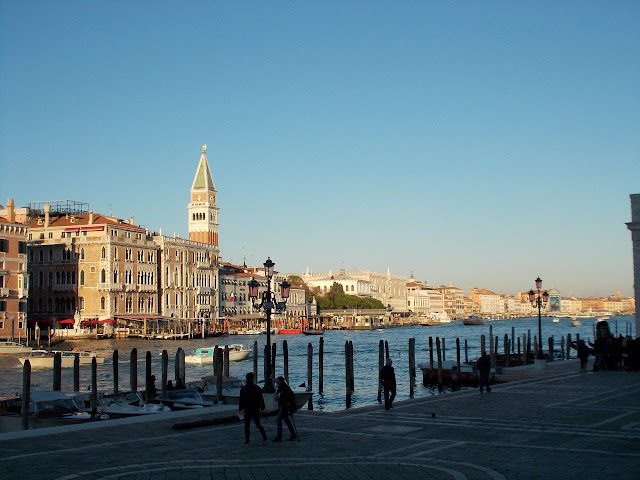 |
| The Palace of the Doge's across the grand canal. |
My introduction to the water bus was not as I imagined it
would be. I had read in guide books and
heard on travel shows how easy the water bus system was to use. After finding the right floating dock that
served as a pick up point for the line we wanted I dug my nose into my newly
purchased guide book reading about the various neighborhoods of Venice and their
attractions. I was thrown off guard and
almost off my feet when the dock shook with the ferocity of what I imagine a
magnitude 7 earthquake feels like. Even
before I could regain my bearings I heard David state “I think our water bus is
here.” It seems the water buses have a
very tight schedule to keep and maintain their timeliness by docking at ramming
speed, allowing the floating dock to slow them down. I would become accustom to this jolting over
our stay. I will say despite the
aggressive docking procedures, the water buses themselves are surprisingly
stable for how choppy the water of the canals and lagoons can get.
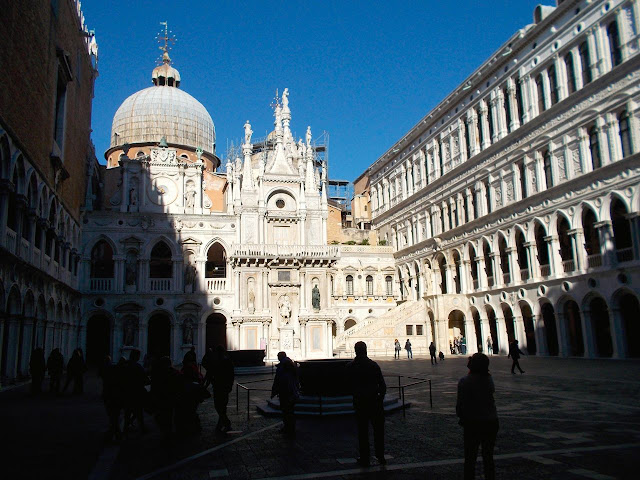 |
| The courtyard of the Doge's Palace, rooms of import surround the courtyard and were added on over hundreds of years. |
Before starting our trip to Venice, I had just finished
reading the section of The Innocents Abroad where Mark Twain visited
Venice. Based on his account, there was
one not to be missed building, the Doge’s Palace, and that museum made our
first goal in Venice. The Doge’s Palace
is located in St. Mark’s Square (so named because St. Marks body is supposedly
interred in the adjacent Basilica).
After the loss of the ruling Romans, Venice became a republic, although
not every person could vote. Any male
adult of the aristocracy whose birth was registered in the golden book
maintained at the Doge’s Palace could vote (up to two thousand) for the governmental
Senate and overseeing Doge, a position similar to our president today. The Doge’s Palace was the setting of all
governmental doings. Everything from
holding elections in one massive room, to senate sessions, and civil and
criminal trials were conducted within its walls.
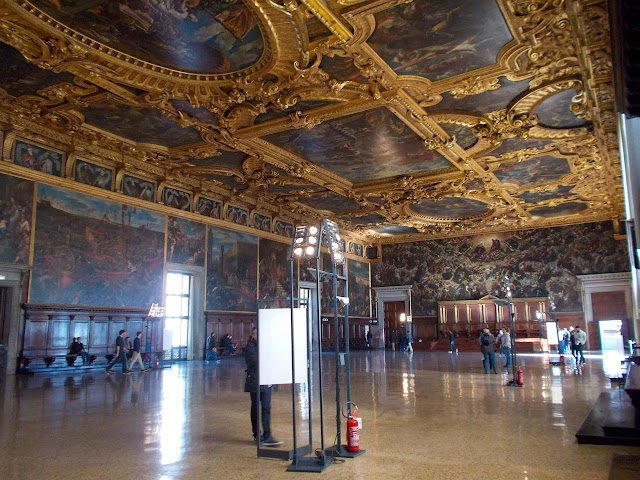 |
| The largest room of the palace, where elections were held. |
Of the number of committees created to govern and rule over
aspects of Venetian law and life, the most feared was the Council of Ten. Comprised of ten members plus the Doge and
six of his advisors (actually making it a council of seventeen), this committee
constantly worked to root out treason and plots of subversion that undermined
the republic. Ancient Venetians took the
health of their republic very seriously, setting up means of for tattle tails
to inform the council of misdeeds via the Lion’s Mouth. The Doge’s Palace was left unlocked, allowing
Venetians to enter the palace at all hours and slip an anonymous note into the
mouth of an engraved face which would then fall, like through a mail slot, into
the offices of the Council of Ten. This
engraved face among the others of Venice were called the Lion’s Mouths and were
strategically placed all over Venice with each mouth calling for specific types
of secrets. Got a neighbor with the
plague who needs to be quarantined?
There’s a Lion’s Mouth for that.
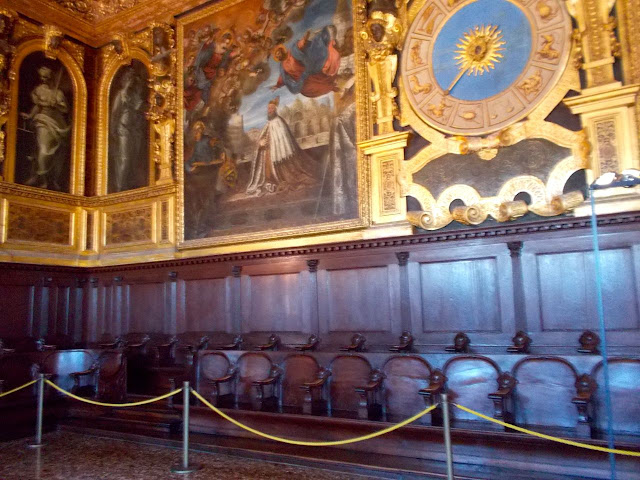 |
| A room for senate meetings in the Doge's Palace. Benches like these line the walls of almost every room in the palace. |
After conviction by the Council of Ten or one of the other
judiciary committees not dealing with treason, prisoners were sent across the
Bridge of Sighs (so named because it is thought prisoners would sigh at their
last view of Venice) into the prisons. I
was aghast at how horrible the prison cells were. Some were as small as office cubicles with a
door only three feet high and a single window the diameter of a softball
above. When I mentioned this to David,
he reminded me these prisons were about punishment, not about rehabilitation
like our prisons of today.
 |
| The chamber of the feared Council of Ten in the Doge's Palace. |
Admission to the Doge’s Palace (eighteen euro) grants
visitors access to four museums in the Saint Mark’s Square area. For a difference of six euro we were able to
upgrade our tickets to include eleven museums of Venice. I love history and art museums and in all we
visited six of the museums Venice has to offer.
 |
| The prison connected to the Doge's Palace by the Bridge of Sighs. Many of the cells had short doorways such as these with a single small window above. |
The first museums we visited after the Dodge’s Palace were
the closest ones, the Correr Museum and Archeological Museum. These museums partially encircle the upper
floors of Saint Mark’s Square. They
contain the rooms of the palace from which monarchs ruled after the fall of the
republic in 1797. Moving through the
museums brought us to the more interesting exhibits which focused on the lives
of Venician citizens. Each room was
dedicated to a specific aspect of Venetian life ranging from their industries
(boat building, glass and lace manufacturing, and trade) to an impressive coin
collection exhibiting almost every coin made by the Republic in its one
thousand year existence.
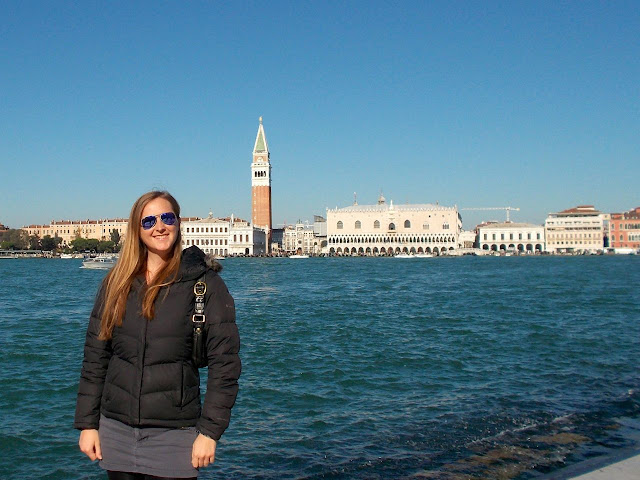 |
| The Doge's Palace as seen from the island San Giorgio Maggiore. |
At some point (I’m not sure when) the Correr Museum turned
into the Archeological museum whose focus is on ancient art. The sheer number of ancient statues was a bit
overwhelming. So I honed in on the
explanatory plaques to guide me through the menagerie of stone. Probably the most interesting exhibit to me
was on ancient duplicates. I had this
idea that prior to the twentieth century every piece of art was unique. I had no idea that as far back as the middle
ages artist were literally making copies of painting and sculptures, doing
their best to make an exact duplicate, or triplicate, or hundrethicate. In the Renaissance of all times when art was
supposed to be undergoing revolution sculptors were still copying statues made
five hundred years prior.
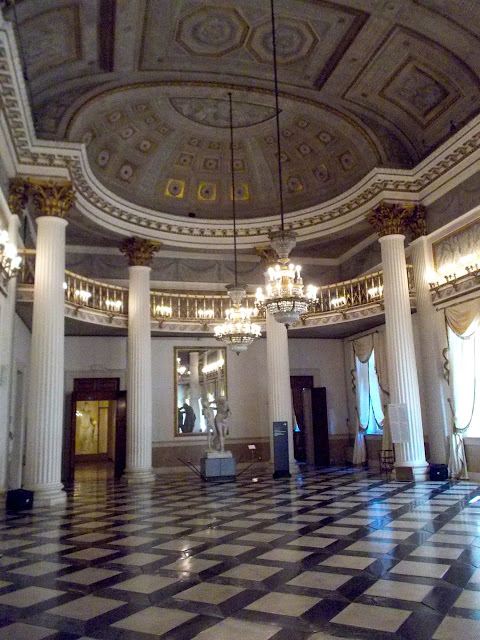 |
| The ballroom of the palace from which monarchs ruled Venice. The upper balcony housed orchestras. |
The next museum on my list was the Museo di Palazzo
Mocenigo, a small museum on the top floor of a house. I wanted to visit this museum despite its
small size because it had an extensive clothing collection of various times of
Venice’s existence. Also it featured a
perfume exhibit across a number of rooms.
I spent so much time sniffing herbs, spices, flowers, and combinations I
couldn’t smell anything for about an hour after we left.
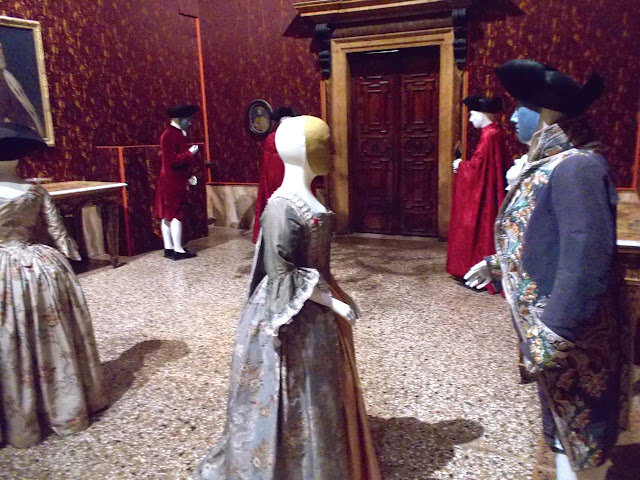 |
| Typical clothing of Venice is shown in the Mueso di Palazzo Mocenigo. The large red capes of the men were worn by elected officials. Other Venetian aristocracy wore similar capes of a flat black. |
The last of the must see museums we wanted to visit was the
Glass Museum. I knew nothing about the
history of glass making before visiting this museum, which provided not only a
history of the trade, but examples to match.
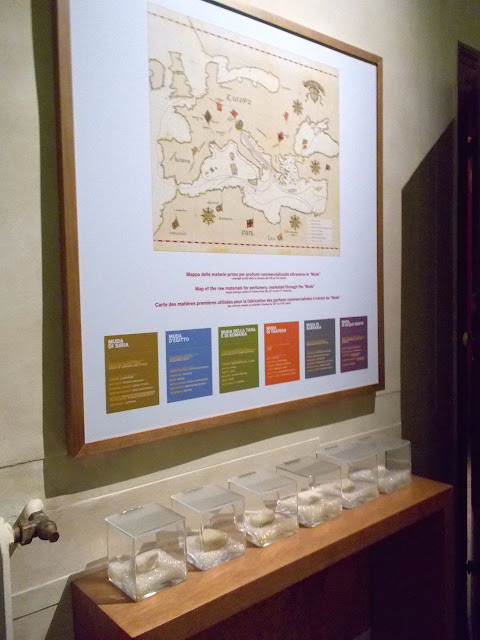 |
| A perfume exhibit in the Mueso di Palazzo Mocenigo. Visiotors can smell mixes of spices in the glass boxes and then see the origins of the spices on the map above. |
Glass was invented in the middle east in the first
century. By the fourth century the
knowledge of glass making had made its way to Venice, mostly due to the strong
trading connections of Venice. Even
though the Venetians did not invent glass making, they sure perfected it and
expanded on the already existing techniques.
Glass making became so prevalent on the Venetian Islands it became a
fire hazard, and all glass making workshops were sent to the Island of Murano,
where the Glass Museum we visited and all glass making shops exist today.
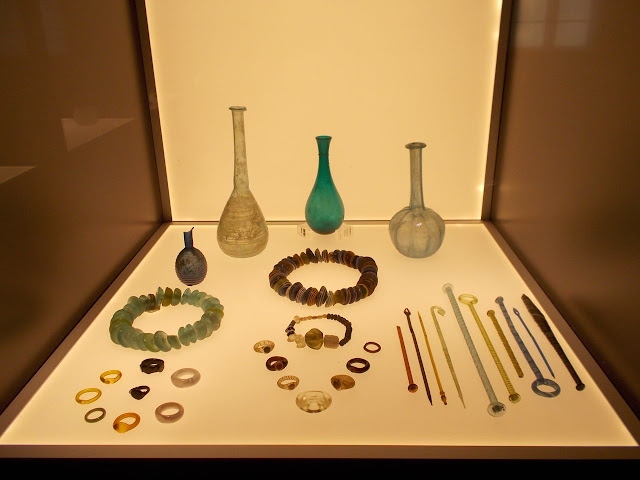 |
| An exhibit of glass from the third or fourth century at the Venitian Glass Museum. |
Despite the skill of Venetian craftsmen, secrets of their
trade got out and eventually the industry declined, causing the closure of many
furnaces. It was within this time though
that glass bead making became the bread and butter of Murano. Unlike blowing glass or using molds, beads
are made by dripping a melted silica mixture onto a wire that is constantly
turned. The museum had thousands of
different beads made this way on Murano. Now Murano’s glass industry has somewhat
recovered due to the development of modern art, with large pieces dramatic and
colorful.
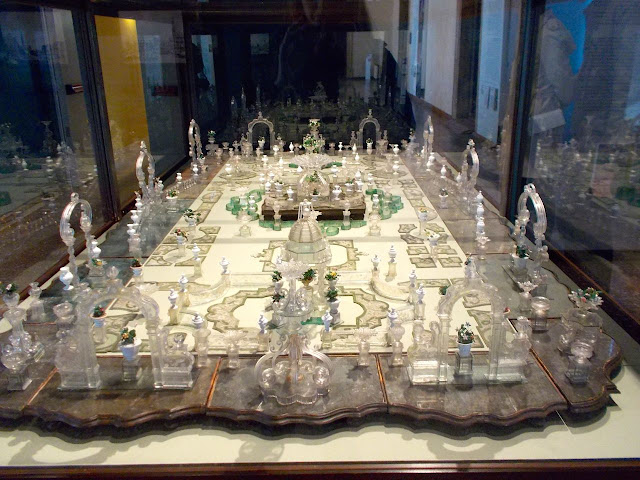 |
| Tablescapes such as this garden scene were popular in the eighteenth and nineteenth centuries. |
Speaking of modern art, the Venetian Museum of Modern Art
was the last museum we visited the morning we left Venice. I am by no means a fan of modern art, but
after the overwhelming number of Renaissance and Gothic statues of the Correr
Museum I wanted a change of pace. Art in
the Venice Museum of Modern Art can only be as old at the mid eighteenth
century. The museum is set up so that
visitors start with the oldest pieces of art and progress to the newer
pieces. By the time we got to the newest
pieces, I was walking straight through the rooms which looked more like
construction sites than an art museum. I
actually mistook a yellow air duct tubing as a part of a renovation project,
not the art piece “tube” that is was.
David noticed the placard explaining the piece as we walked out the building. A few days before our trip to Venice I actually read an article where a custodian at an Italian museum accidentally threw out a piece of modern art which resembled a pile of trash. I understand now how that mistake could be made.
 |
| Some of the most recent and largest pieces in the Glass Museum. |
While I wasn’t thrilled with the modern art, I think it made
me appreciate the art of the Renaissance all the more, which is good since our
next stop on our itinerary was Florence, birthplace of the Renaissance. The upper floors of the museum featured an
Asian art collection, which was some private collection of swords, board games,
suits of armor, hats, and other random pieces that some Venetian noble acquired
on his trip around the world.
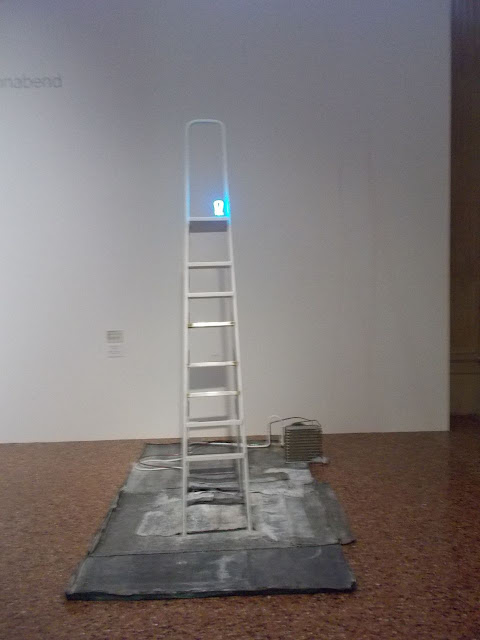 |
| It's no wonder custodians can mistake modern art for a pile of garbage that needs to be cleaned up, as this piece in the Venetian Museum of Modern Art shows. |
The last museum I want to mention is one I could have
skipped, it was the Venice Museum of Natural History. I love natural history museums, and not necessarily
large ones. I’ve already posted about
how I much I loved the Paige Museum of the La Brea tar pits, and that museum is
tiny. Unfortunately the Venice Museum of
Natural History was lacking any sort of original display or interactive
features. It was basically room upon
room of stuffed animals on display with no English explanations. Even the Italian explanation plaques were
brief. It was very canned. I am happy we did not pay for entry (it was
included in the Museum Pass).
 |
| Here I am so excited going into the Venetian Museum of Natural History. I would be so disappointed going out. |
Aside of museums, Venice has a lot of churches. We visited six of them. The first, San Giorgio Maggiore was probably
my favorite because it has its own island.
It’s also filled with large modern art sculptures that contrast nicely
with the sixteenth century brass altar.
 |
| We saw this giant mesh head in the church of San Giorgio Maggiore. |
We also found the church from Indiana Jones and the Last
Crusade. It’s the church in the movie
that was converted into a library underneath which they find the shield with
the map on the dead knight’s body. In
reality only the outside of the church was used in the movie. The church was not converted to a library,
but an art gallery. Art is just everywhere
in Venice.
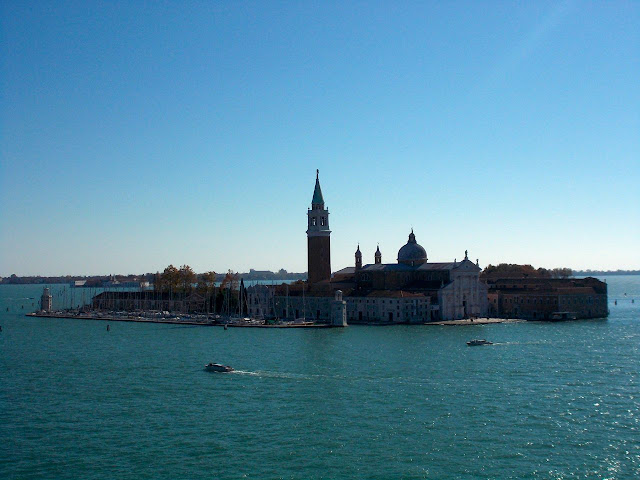 |
| The island and church of San Giorgio Maggiore. |
One more thing which seems to be everywhere in Venice are
bell towers. From our hotel room, I
would hear every morning starting at six several bell towers chime the
hour. While it really only take fifteen
seconds to chime six the entire occurrence takes a few minutes, because the
towers are not synced. First one will
start, then another ten seconds later, then another a few seconds after
that. Bells and the constant sound of
suitcases rolling over stone streets (no cars) make up the sounds of
Venice. In a way the constant sounds of
tourists struggling with their suitcases is a sign of the health of Venice’s
economy. Without tourism Venice’s
economy would have sunk faster than its land is currently sinking into the
lagoon.
 |
| David standing in front of the Venetian church used in Indiana Jones and he Last Crusade. |
On the first day I was confused as to the stack of tables
strung along the streets of Venice. What I thought were tables are actually walking
platforms placed in line when a rather high tide is expected and the streets
flood. Thankfully we missed such a high tide,
but it serves as a reminder as to why we should visiting Venice now and not
later. Venice is going under.
The absolute last thing we accomplished in Venice and one of
my favorite was a trip to the fish market (although this market includes
produce and butchers as well). The
market wraps up by the afternoon, making a morning visit a must. The market place was filled to the brim with
seafood so fresh, some of it was still moving.
I’m not kidding. At one point I
saw a fish monger picking jumping shrimp out of the ice surrounding his shrimp
display, throwing them back onto the pile with their buddies who had resigned
their fate.
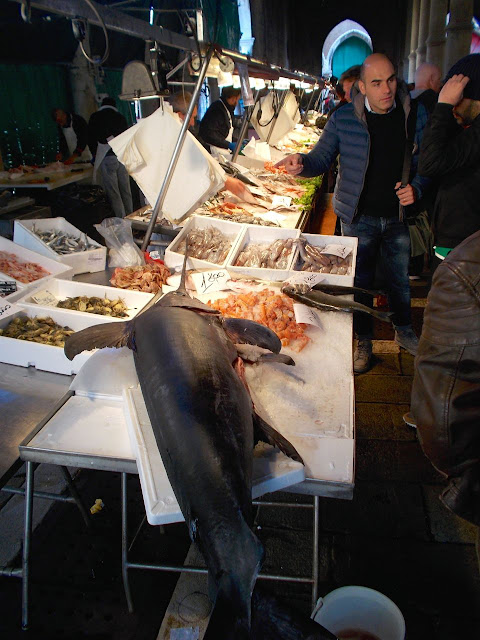 |
| Some of the products still move at the Venetian fish market. |
Beyond the stalls of sardines and swordfish were the produce
stands. Of course their were oranges,
bananas, and apples, but what really caught my eyes were the piles and piles of
sun dried tomatoes. I love sun dried
tomatoes and I could not believe how inexpensive they were, about half the
price of what I see them in the US. I
bought a small bag’s worth for a healthy snack later in the day on the
train.
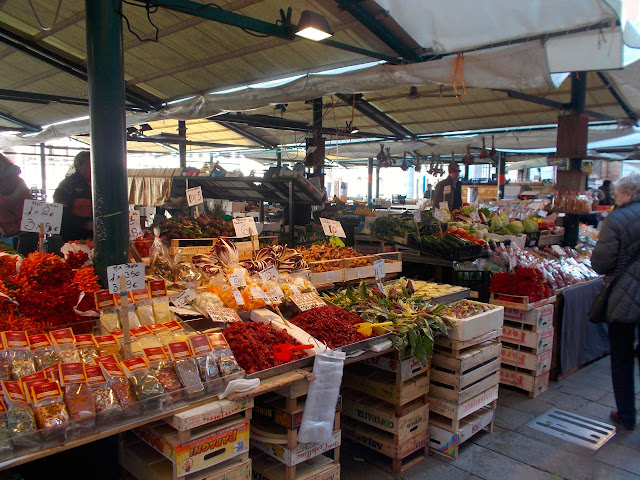 |
| Piles of sun dried tomatoes are common in the Venetian fish market. |
A few notes on practical matters before I end this
post. We visited Venice in early November
well into the off-season. Some may think
this is not the time to visit Venice due to the cold, but I found it
pleasant. There was no snow on the
ground, and a moderate jacket and jeans was all I needed to stay warm. In contrast I feel like visiting in the summer
might be overbearingly hot. Plus on the
weekdays the city was nicely not crazy busy.
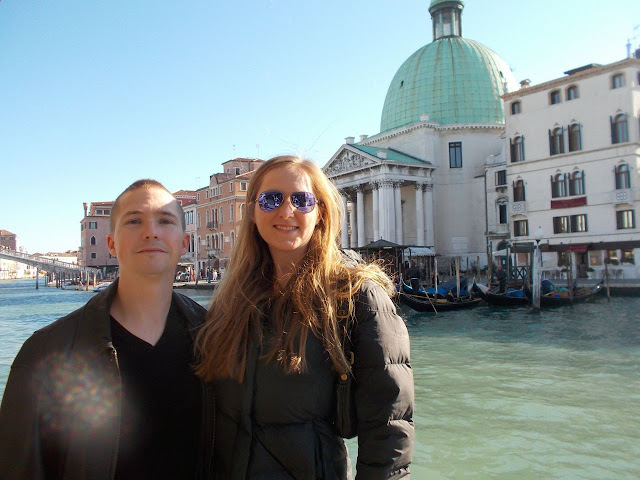 |
| Happy on our first day in Venice on the the Grand Canal. |
We arrived to Venice by plane and departed by bus. The train station is located on the
main island of Venice and is so easy to use; we bought our tickets seven
minutes before the train departed from a kiosk and still made it on board
without a problem. The airport, while
small is located on the mainland of the Venice municipality. We found three options to get from the
airport to the main island. We could
take a private water taxi for over one hundred euro, take a ferry for fifteen
euro each, or take a bus for eight euro each.
We saved our money and took the bus.
The bus only makes two stops, the airport and the island and the airport
pick up is right outside the doors of baggage claim.
 |
| The streets of the island of Murano are much less busy than that of the main island of Venice. |
As I already mentioned, the city does flood during the highest tides. This did not happen during our visit. When the city does flood, platforms are
erected that are strategically stacked all around the city. During flooding tides these platforms are set
up to make walkways down some of the streets and up to major points of
interest. They don’t go up to every door
however. The rest of the time they lie
in piles on the streets serving as benches for tired locals and tourists. The platforms stand as a constant reminder
that the city has a limited amount of time above water left.
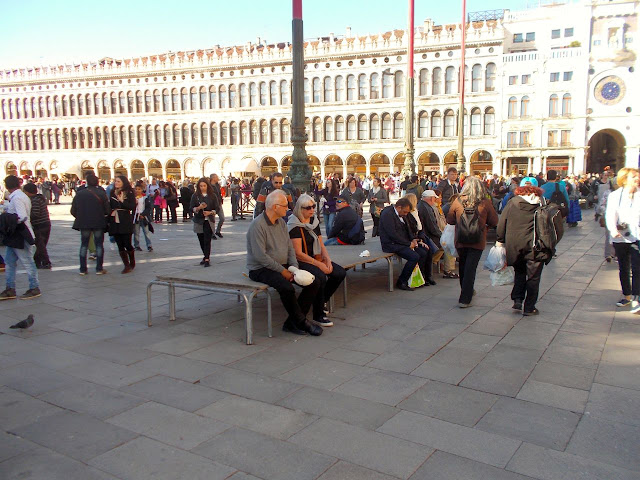 |
| Tourists rest on the piles of platforms which serve as walkways during the highest tides. |
Venice is a maze. I researched a few restaurants to eat at ahead of time. I found none of them until I accidentally ran into one of the bars on our way out of the city in the morning. Finding super popular areas like the Rialto Bridge or Saint Mark's Square are easy to find, but small restaurants and bars are not. Be flexible when it comes to dinning, and above all make the most of your time in this marvelous city.
No comments:
Post a Comment